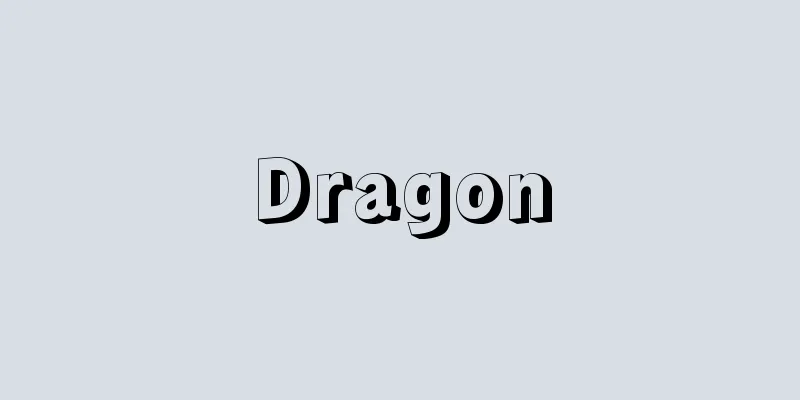Dragon

|
An imaginary animal. It is depicted as a giant reptile with a snake's body, two deer-like horns on its head, long whiskers at its mouth, 81 hard scales on its back, and five fingers on each of its four legs. It is also called Tatsu. In ancient China, it was considered the leader of scale insects and was viewed as one of the four auspicious creatures along with the Chinese phoenix and turtle. In Buddhism, there are eight dragon kings known as the Eight Great Dragon Kings, and the Sagara Dragon King is believed to be in charge of the sea and rain, and is therefore worshipped as the guardian deity of sailing and the god of rainmaking. In Japan, rainmaking festivals are held in ponds where dragons are said to live, and this belief is the same as the one that is used. Mount Togakushi, famous for its mountain religion, is where Kuzuryu Gongen is enshrined, and the pond where this dragon lives is also a place of prayer for rain. Legends that attribute heavy rains and floods to the dragon's anger also reflect the idea that the dragon controls water. On the other hand, the story of Toyotamahime in the Kojiki and Nihon Shoki myths is one example of a connection with the sea god. The Nihon Shoki records that Toyotamahime, the daughter of the sea god, entered the birthing house to give birth and took on the form of her home country, becoming a dragon. Even today, fishermen believe that dragons are sea gods who protect bountiful catches and safety at sea. One of the fishermen's popular beliefs is that metal objects should not be dropped at sea, which is said to be because the dragon god dislikes iron. It is generally believed that snakes dislike iron. This tells us that at the root of the belief in the dragon god is the belief in the snake, which is a symbol of the water god. Dragons are also closely related to the god of thunder. Dragons fly through the sky, creating rain and clouds, and are said to shoot snake-shaped lightning bolts. The phrase "a dragon ascends to heaven" is used as an analogy for a sage becoming the emperor or a hero's glorious deeds, but it certainly describes the force of a dragon ascending to heaven. In China, there has long been the belief that dragons ascend to heaven on rain clouds. A similar belief exists in Japan, where dragon gods ascend to heaven when tornadoes occur. In Okinawa, there is an old story that goes like this: A man finds a viper sleeping at the base of a mulberry tree. When the viper wakes up, it transforms into a hermit, and if it spends a thousand years in the mountains, a thousand years in the sea, and a thousand years in the hills, it will ascend to heaven and become a dragon, but it cannot ascend if it is seen by others, so it ascends to heaven on the condition that it never tells anyone about it. The man keeps his promise and becomes wealthy for a time, but one day he accidentally lets it out, and from then on he returns to his former poverty. In one story from Aomori Prefecture, a giant snake complains to a woodcutter that a large Katsura tree is in the way and it cannot ascend to heaven. The woodcutter then cuts down the Katsura tree and allows the snake to ascend to heaven. The motif of a snake on earth ascending to heaven and becoming a dragon over the years is seen as a process in which snake worship changes into dragon god worship. The dragon's home is called Ryugu, and is said to be in a cave, lake, or at the bottom of the sea. It is said that the dragon god lives with Princess Otohime. Among the tales about Ryugu, the most well-known is the legend of "Ryugubuchi". It is said that the pool leads to Ryugu, and that sometimes the sound of weaving can be heard from the pool. It is also said that if you ask to borrow a bowl or dinner plate, the bowl will be provided. However, it is said that someone was nasty and did not return it, so the bowl was no longer available. There are several old tales that have the motif of humans visiting Ryugu. A typical example is "Urashima Taro". It can be found in the ancient "Tango no Kuni Fudoki" and "Manyoshu". Other old tales of the same genre include "Ryugu Buchi" and "Ryugu Nyobo". In "Ryugu Doji," a poor man throws some firewood into the water, and as a token of gratitude, a turtle guides him to the Dragon Palace. He receives a little boy with a snotty nose as a souvenir from the Dragon Palace. If he takes good care of the boy, he becomes wealthy, but becomes arrogant and treats him carelessly, and so he returns to his former state. In "Ryugu Nyobo," a powerful man falls in love with a woman who comes from the Dragon Palace as a bride, and gives her difficult problems, but she solves them with her wisdom, and they live happily ever after. These stories share a common element in which a person chosen by a god visits the Dragon Palace and gains wealth. In ancient times, the Dragon Palace was also called Tokoyo no Kuni, and it was considered a kind of utopia and at the same time a source of wealth. Such beliefs are reflected in the tales. There is a European folk tale called "Slaying the Dragon." The story is about a young man with a dog who slays a dragon that demands the princess as a sacrifice, and ends up marrying her. In our country's folk tale, this corresponds to "Slaying the Monkey God." Generally, European dragons are the embodiment of large snakes, and are considered to be the incarnations of evil gods. They guard treasures and the like, but are ultimately destined to be killed by heroes or gods. Eastern dragons generally have a strong tendency to be associated with real life and are seen as benevolent gods that bring happiness to people. Their tendency to seek harmony rather than hostility seems to reflect the ethnic character of the people. [Junichi Nomura] [References] | | | | | |Part of the barrier in front of the palace gate, built during the reign of Emperor Hongwu of the Ming Dynasty. Made of five-colored lapis lazuli tiles, it is 8m tall. In China, the shape of a dragon appears on ancient bronze vessels from the Yin and Zhou dynasties, but it is believed that the modern form was established during the Han dynasty. In particular, the five-clawed dragon was considered a symbol of the emperor, and was used as a design for palace architecture and clothing. Datong, Shanxi Province, China ©Shogakukan "> Nine Dragons Wall Source: Shogakukan Encyclopedia Nipponica About Encyclopedia Nipponica Information | Legend |
|
想像上の動物。胴体はヘビ、頭にはシカのそれに似た角が2本あり、口のところに長いひげを生やし、背には81枚の堅い鱗(うろこ)をもち、4本の足にはそれぞれ5本の指を備えた巨大な爬(は)虫類として描かれる。タツともいう。中国では、古来鱗虫の長とされ、麟(りん)、鳳(ほう)、亀(き)とともに四瑞(しずい)の一つとして神霊視された。仏教では八大竜王といって8種の竜王がいるが、そのなかの娑伽羅(しゃがら)竜王が海や雨をつかさどるとされることから、航海の守護神や雨乞(あまご)いの神として信仰される。わが国の民間で、雨乞い祭りの際に、竜が住むという池の水を用いたり、またその池で行われたりするのは、この信仰と同一である。山岳宗教で名高い戸隠(とがくし)山には九頭竜権現(くずりゅうごんげん)が祀(まつ)られているが、この竜の住む池がやはり雨乞いの祈願所になっている。大雨や洪水などの現象を竜の怒りとする言い伝えにも、竜が水をつかさどるという意識が表れている。一方、海神とのかかわりが指摘されるものに、記紀神話の豊玉姫(とよたまひめ)説話があげられる。海神の娘である豊玉姫がお産のために産屋(うぶや)に入り、本(もと)つ国(くに)の姿になったようすを『日本書紀』では竜になったと記している。現在でも漁民の間では、竜は豊漁や海上安全を守護する海神として信仰されている。その漁民の俗信のなかに、海上で金物類を落としてはならないとする禁忌があるが、それは鉄を竜神が嫌うからだといわれる。一般に鉄を嫌うのは蛇とされる。このことは、竜神信仰の根底に水神の表徴である蛇信仰の存するのを教えてくれる。 竜はまた雷神ともかかわりが深い。竜は中空を飛行して雨や雲をおこしたり、蛇の形をした稲妻を放つとされる。「竜天に昇る」ということばは、聖人が天子につくことや英雄の華やかな活躍のたとえに用いられるが、まさに竜が天に昇るような勢いの謂(いい)であろう。中国では竜が雨雲にのって昇天するという考え方が古くからある。わが国でも同様な考え方はあって、竜神は竜巻のときに昇天するのだという。沖縄には次のような昔話がある。男が桑の木の根元に寝ているハブをみつける。目を覚ましたハブは仙人に姿を変え、山で千年、海で千年、丘で千年過ごすと天に昇って竜になれるが、それを人に見られては昇れないので、このことを絶対に他言しないという約束で昇天する。男は約束を守り一時裕福になるが、あるときうっかり口にしてしまい、以後はもとの貧乏に戻るという内容の話である。青森県の話には、大蛇が、桂(かつら)の大木がじゃまになって昇天できないと木こりに訴える。そこで木こりはその桂の木を伐(き)って昇天させたという例がある。地上の蛇が年月を経て昇天し竜になるというモチーフは、蛇信仰が竜神信仰へと変化していく過程とみなされる。 竜のすみかは竜宮とよばれ、その場所は洞窟(どうくつ)、湖沼や海の底にあるとされる。竜神は乙姫(おとひめ)様と住んでいるという。そうした竜宮に関する説話のなかで、よく知られているのが「竜宮淵(ぶち)」の伝説である。その淵が竜宮に続いているといって、ときおりその淵から機(はた)織りの音が聞こえてくるとか、またその淵に必要な膳椀(ぜんわん)を貸してくれるように依頼すると用意してくれるという。ただし心がけの悪い者がいて返さなかったために、貸してくれなくなったと伝えている。昔話のなかには、人間が竜宮を訪問するというモチーフの話がいくつかある。その代表的な例が「浦島太郎」である。古くは『丹後国風土記(たんごのくにふどき)』や『万葉集』にもみえる。同系統の話としてほかに「竜宮童子」「竜宮女房」といった昔話もある。「竜宮童子」は、貧乏な男が薪(まき)を水中に投下すると、そのお礼にといって亀(かめ)が竜宮に案内する。竜宮からの土産(みやげ)にハナタレ小僧をもらう。その小僧をだいじにすると豊かになるが、慢心して粗末にするので元の状態に戻ってしまうというのがその内容である。「竜宮女房」は、竜宮から嫁にきた女房に対して、権力者が横恋慕して難題を課してくるが、女房の知恵で解決し幸福に暮らすという話である。これらの話には、神に選ばれた人間が竜宮を訪問し、富を得るという共通した要素がみいだされる。古代には竜宮は常世国(とこよのくに)ともよばれ、それは一種の理想郷であり、同時に富の源泉として意識されていたのであった。そうした信仰が説話に反映されているのである。 ヨーロッパの昔話に「竜退治」という話がある。犬を連れた若者が、王女をいけにえに求める竜を退治し、王女と結ばれるという内容の話である。わが国の昔話では「猿神退治」に相当する。一般にヨーロッパの竜は、大ヘビを形象化したもので、悪神の化身のように考えられている。宝物などを守っているが、ついには英雄や神々に殺される運命にある。東洋の竜は総じて、現実生活と結び付いて人々に幸福を招来する善神としての傾向が強い。敵対するよりは調和を求めようとする一面は、その民族的性格を反映しているようである。 [野村純一] [参照項目] | | | | | |明の太祖洪武帝時代に建造された王府門前の障壁(部分)。五色の瑠璃瓦でつくられ、高さ8m。中国では、古く殷・周の青銅器に竜の形が現れるが、現在のような姿に定着するのは漢代と考えられている。とくに5本の爪をもつ竜は天子の象徴とされ、宮廷の建築や服飾の意匠として使用された。中国 山西省大同©Shogakukan"> 九龍壁 出典 小学館 日本大百科全書(ニッポニカ)日本大百科全書(ニッポニカ)について 情報 | 凡例 |
Recommend
Sinobambusa tootsik (English spelling)
...Rikuchudake ( S. kagamiana Makino) is the most...
Shao Yong
A Chinese thinker from the Northern Song Dynasty....
Child play - Shuyu
A disciple of Confucius (Kongqiu). His surname wa...
Dachinkashigi - wage earning
Carrying luggage or passengers on a horse's ba...
tan
… [Trigonometric ratios] In a right-angled triang...
Hazakasa craft - Haritsuzaiku
〘Noun〙 A unique lacquer craft item made by Ogawa H...
Barley bread - Oomugipan
… In ancient Greece, leavened bread was baked aro...
Stock split
Splitting one share into several shares to increas...
Hanaikari (flower anchor) - Hanaikari (English spelling) Halenia corniculata; spurred gentian
This biennial plant of the Gentianaceae family is ...
Ogawa Hanbei
?-? A Joruri composer from the mid-Edo period. He...
Summer -
①The oldest legendary dynasty in China ②One of the...
Sea cave - Kaishokudomon
A sea cave formed by wave erosion that cuts throug...
Flowers of the Heart
Founded by Sasaki Nobutsuna in February 1898 (Mei...
Industrial Safety and Health Act
Abbreviation for "Occupational Safety and Hea...
Rain erosion
Erosion caused by rainfall. There are three types...









